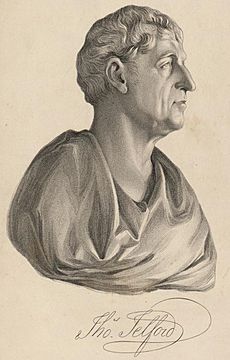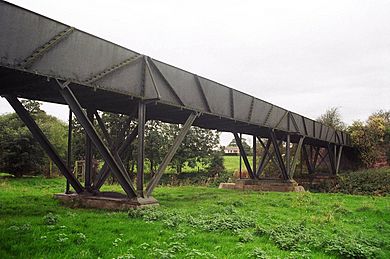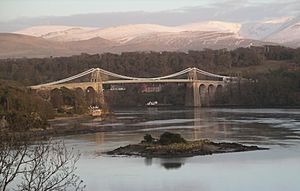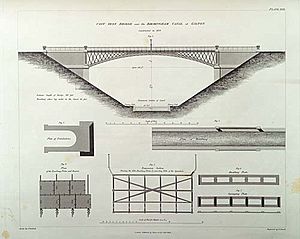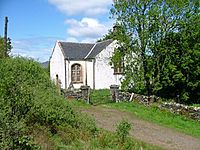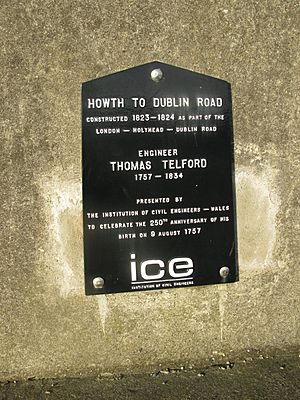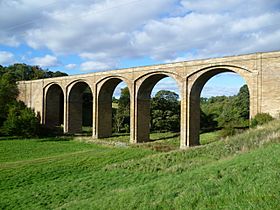Thomas Telford facts for kids
Quick facts for kids
Thomas Telford
FRS FRSE
|
|
|---|---|
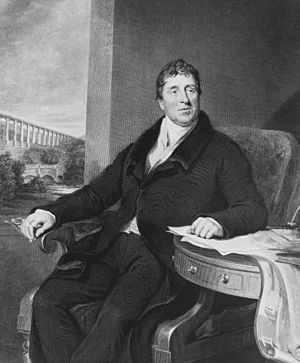 |
|
| Born | 9 August 1757 Glendinning, Westerkirk, Eskdale, Dumfriesshire, Scotland
|
| Died | 2 September 1834 (aged 77) Westminster, London, England
|
| Occupation | Engineer |
| Engineering career | |
| Discipline | Civil |
| Institutions | Founder and first President of the Institution of Civil Engineers (1818) |
| Projects |
|
Thomas Telford (born August 9, 1757 – died September 2, 1834) was a famous Scottish civil engineer. He became known for building roads and canals in a place called Shropshire, England. Later, he designed many big projects in his home country of Scotland, including harbors and tunnels.
People called him the Colossus of Roads. This nickname meant he was a giant in building highways and bridges. He was so good at all kinds of civil engineering that he became the first president of the Institution of Civil Engineers. He held this important job for 14 years until he passed away.
The town of Telford in Shropshire was named after him.
Contents
Early Life and Work
Thomas Telford was born on August 9, 1757. He grew up on a small farm in a rural area of Scotland called Eskdale. His father, John Telford, was a shepherd who died shortly after Thomas was born. Thomas was raised by his mother, Janet Jackson, and they lived in poverty.
When he was 14, Thomas started training as a stonemason. Some of his early work can still be seen on a bridge over the River Esk in Langholm. He worked for a while in Edinburgh. In 1782, he moved to London. There, he helped build parts of Somerset House.
Two years later, he got a job at Portsmouth dockyard. Even though he mostly taught himself, he became skilled at planning, designing, and managing building projects.
In 1787, a rich supporter named William Pulteney helped him become the Surveyor of Public Works in Shropshire. His projects included fixing Shrewsbury Castle and the town's prison. He also worked on churches like Church of St. Mary Magdalene, Bridgnorth and St Michael in Madeley. Once, he warned that St Chad's Church, Shrewsbury was about to fall down, and it did, just three days later! This made him well-known in the area.
Building Bridges
As the county surveyor, Telford was also in charge of bridges. In 1790, he designed a bridge over the River Severn at Montford. This was the first of about 40 bridges he built in Shropshire. These included big crossings over the Severn at Buildwas and Bridgnorth.
The bridge at Buildwas was Telford's first iron bridge. He learned from Abraham Darby's famous Iron Bridge. Telford noticed that Darby's bridge was much stronger than it needed to be. In contrast, Telford's iron bridge was wider but weighed half as much. He was one of the first engineers to test his building materials carefully before using them.
In 1795, floods washed away the bridge at Bewdley in Worcestershire. Telford designed its replacement. The same floods also destroyed the bridge at Tenbury. Telford was responsible for fixing the northern part of this bridge.
Designing Canals
Telford's good reputation in Shropshire led him to a big job in 1793. He was chosen to design and build the Ellesmere Canal. This canal would connect ironworks and coal mines in Wrexham to Chester and the River Mersey.
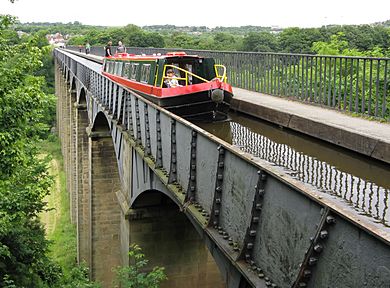
One amazing part of this project was the Pontcysyllte Aqueduct over the River Dee. Telford used a new way to build it, using troughs made of cast iron plates set in stone. This aqueduct is over 1,000 feet (300 meters) long and 126 feet (38 meters) high above the valley floor. It has nineteen arches, each 45 feet (14 meters) wide. Since he was a pioneer in using cast-iron for such large structures, Telford had to invent new methods, like using boiling sugar and lead to seal the iron parts.
Another famous engineer, William Jessop, oversaw the project. But he left the detailed work to Telford. In 2009, the Pontcysyllte Aqueduct was named a UNESCO World Heritage Site.
During this time, Telford also worked on the Shrewsbury Canal. When the first engineer died in 1795, Telford took over. One of his achievements here was the Longdon-on-Tern Aqueduct. This was a cast-iron aqueduct built before Pontcysyllte. It was much bigger than the first cast-iron aqueduct in the UK. This aqueduct is no longer used but is kept as an important piece of engineering history.
The Ellesmere Canal was not fully finished because it didn't make enough money. However, Telford's skills meant he was always asked for advice on other projects. These included water systems for Liverpool and improvements to London's docklands.
Scottish Highlands Project
In 1801, Telford created a huge plan to improve travel in the Scottish Highlands. This massive project lasted about 20 years. It included building the Caledonian Canal and improving parts of the Crinan Canal. He also built about 920 miles (1,480 km) of new roads and over a thousand new bridges, like the Craigellachie Bridge. He improved many harbors, including those at Aberdeen and Dundee, and built 32 new churches.
Telford also worked on roads in the Scottish Lowlands. He built 184 miles (296 km) of new roads and many bridges. These ranged from a 112-foot (34-meter) stone bridge over the Dee at Tongueland to the 129-foot (39-meter) tall Cartland Crags bridge near Lanark.
In 1809, Telford was asked to improve the Howth Road in Dublin, Ireland. This road connected a new harbor to the city. The milestones along this route still mark the way. He also designed the first plan for the Ulster Canal. An Irish engineer named William Dargan was trained by Telford.
In 1806, the King of Sweden asked Telford for advice on building a canal between Gothenburg and Stockholm. Telford's plans were accepted, and construction of the Göta Canal began in 1810. Telford traveled to Sweden to oversee some of the first digging.
Many of Telford's projects were funded by the Exchequer Bill Loan Commission. This group was set up in 1817 to help pay for public works that would create jobs.
The 'Colossus of Roads'
In his later years, Telford was in charge of rebuilding parts of the London to Holyhead road. His assistant, John Benjamin Macneill, finished this job. Today, much of this route is the A5. Between London and Shrewsbury, Telford mostly improved existing roads. But beyond Shrewsbury, he often built new highways from scratch.
Important parts of this route include the Waterloo Bridge over the River Conwy and the road climbing to Capel Curig. On the island of Anglesey, a new embankment was built. But the biggest challenge was crossing the Menai Strait. Telford solved this with the Menai Suspension Bridge (1819–26). At 580 feet (177 meters) long, it was the longest suspension bridge of its time. Instead of modern cables, Telford used connected iron bars for the bridge's support.
Telford also worked on the North Wales coast road between Chester and Bangor. This included another major suspension bridge at Conwy, which opened the same year as the Menai bridge.
Further away, Telford designed a road across the center of the Isle of Arran. This route, called the 'String road', goes through tough land. It allows people to travel between east and west Arran without going all the way around the coast. His work on improving the Glasgow – Carlisle road was seen as a great example for future engineers.
Telford improved how macadam roads were built. He made sure to choose the right size of stones based on how much traffic the road would have, its turns, and its slopes.
His friend, the poet Robert Southey, gave Telford the clever nickname Colossus of Roads.
In 1821, he became a foreign member of the Royal Swedish Academy of Sciences.
The 'Telford Church'
In 1823, a law was passed that gave £50,000 to build up to 40 churches and homes for ministers in areas that didn't have any churches. These were sometimes called 'Parliamentary Churches'. Telford was asked to design them. He created a simple T-shaped church plan and two designs for ministers' homes. These designs could be changed to fit different locations and be built with brick or stone.
Out of 43 planned churches, 32 were built across the Scottish highlands and islands. The last of these churches was finished in 1830. Some have been restored or turned into private homes.
Later Projects
Telford's other projects include the St Katharine Docks (1824–28) near Tower Bridge in London. He also worked on the Gloucester and Berkeley Ship Canal, now called the Gloucester and Sharpness Canal. He built the Over Bridge near Gloucester and the second Harecastle Tunnel on the Trent and Mersey Canal (1827).
The Birmingham and Liverpool Junction Canal (now part of the Shropshire Union Canal) was started in 1826. It was finished in 1835, after Telford's death. When it was built in 1829, Galton Bridge had the longest single span in the world. Telford also planned the Macclesfield Canal. He built Whitstable harbor in Kent in 1832, which was connected to the Canterbury and Whitstable Railway. He also completed the Grand Trunk canal after the original engineer, James Brindley, died.
In 1820, Telford became the first President of the Institution of Civil Engineers. He held this position until he died.
Thomas Telford's Death
Thomas Telford was buried in Westminster Abbey, a very famous church in London. A statue of him was placed nearby.
Throughout his life, Telford loved his birthplace in Eskdale and its people. In his will, he left money to the two local libraries there.
Honors and Recognition
In 2011, Thomas Telford was one of the first seven people to be included in the Scottish Engineering Hall of Fame.
Telford the Poet
Telford was also known for his writing, even before he became famous as an engineer. He published poems between 1779 and 1784. He also wrote about a trip to Scotland with his friend, the poet Robert Southey. In his will, he left gifts to Southey (who later wrote Telford's life story), to the poet Thomas Campbell, and to the publishers of the Edinburgh Encyclopædia, which he had helped write.
Another engineer, George Turnbull, said that Telford wrote him a poem about the death of the famous Scottish poet Robert Burns:
On reading an account of the death of ROBERT BURNS, the SCOT POET
CLAD in the sable weeds of woe,
The Scottish genius mourns,
As o'er your tomb her sorrows flow,
The "narrow house" of Burns.'
Each laurel round his humble urn,
She strews with pious care,
And by soft airs to distance borne,
These accents strike the ear.
Farewell my lov'd, my favourite child,
A mother's pride farewell!
The muses on thy cradle smiled,
Ah! now they ring thy knell.
---- ten verses and then ----
And round the tomb the plough shall pass,
And yellow autumn smile;
And village maids shall seek the place,
To crown thy hallowed pile.
While yearly comes the opening spring,
While autumn wan returns ;
Each rural voice shall grateful sing,
And SCOTLAND boasts of BURNS.
22nd August, 1796. T.T.
Later in his life, Telford wrote another poem called To Sir John Malcolm on Receiving His Miscellaneous Poems (1831).
Bridges Designed by Telford
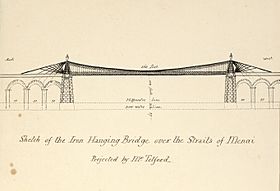
Here are some of the many bridges and aqueducts Telford designed:
| Year | Name/Location |
|---|---|
| London Bridge proposal | |
| Potarch Bridge | |
| 1792 | Montford Bridge |
| 1796 | Buildwas bridge |
| 1796 | Longdon-on-Tern Aqueduct |
| 1797 | Coundarbour Bridge |
| 1798 | Bewdley Bridge |
| 1801 | Chirk Aqueduct |
| 1805 | Pontcysyllte Aqueduct |
| 1806 | Glen Loy Aqueduct, Caledonian Canal |
| 1808 | Tongland Bridge |
| 1809 | Dunkeld Bridge |
| 1810 | Bridgnorth bridge |
| 1811 | Helmsdale bridge |
| 1812 | Bonar Bridge |
| 1813 | Telford Bridge, Invermoriston |
| 1815 | Craigellachie Bridge |
| 1815 | Dunans Bridge |
| 1815 | Waterloo Bridge, Betws-y-Coed |
| 1818 | Sligachan Old Bridge |
| 1819 | Bannockburn Bridge |
| 1820 | Cantlop Bridge |
| 1823 | Stanley Embankment |
| 1824 | Eaton Hall Bridge |
| 1826 | Conwy Suspension Bridge |
| 1826 | Menai Suspension Bridge |
| 1826 | Mythe Bridge |
| 1827 | Holt Fleet Bridge |
| 1827 | Over Bridge |
| 1827 | Bridge of Keig |
| 1829 | Galton Bridge |
| 1831 | Dean Bridge, Edinburgh |
| 1831 | Lothian Bridge, Pathhead |
| 1832 | Broomielaw Bridge, Glasgow |
Places Named After Thomas Telford
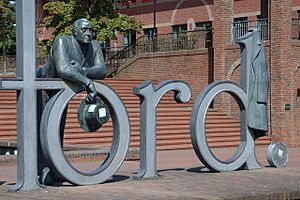
Many places are named to remember Thomas Telford:
- Telford New Town in Shropshire, England.
- Thomas Telford School.
- Thomas Telford Road in Langholm, where he was an apprentice.
- Telford Hall, a student residence at Loughborough University.
- Telford, Pennsylvania, a town in the USA, named after him in 1857.
- Telford College, Edinburgh.
- Telford Bridge (footbridge) in Dartmouth, Nova Scotia, Canada.
- Thomas Telford Basin, a part of a housing area on the Ashton Canal in Manchester.
His Own Story
Telford's autobiography, called The Life of Thomas Telford, Civil Engineer, written by himself, was published after he died in 1838.
|
See also
- Thomas Telford para niños (In Spanish)
- Telford Medal
People Thomas Telford Knew
- Charles Atherton, another civil engineer
- Hugh Baird (engineer), another civil engineer
- Hamilton Fulton, another civil engineer
- John Gibb (engineer), another civil engineer
- William Hazledine, who supplied iron for many of Telford's projects
- William Jessop, another civil engineer
- John Benjamin Macneill, another civil engineer
- Sir William Pulteney, 5th Baronet, a supporter of Thomas Telford
- William Reynolds (industrialist), who built the Longdon-on-Tern Aqueduct for Telford
- George Turnbull (civil engineer), another civil engineer


